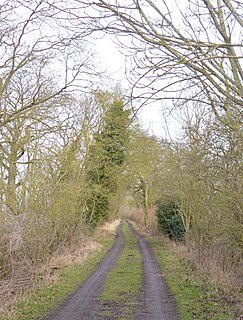| Raveley Wood | |
|---|---|
 | |
| Type | Nature reserve |
| Location | Upwood, Cambridgeshire |
| OS grid | TL 244 817 |
| Area | 5.6 hectares |
| Managed by | Wildlife Trust for Bedfordshire, Cambridgeshire and Northamptonshire |
Raveley Wood is a 5.6 hectare nature reserve south-west of Upwood in Cambridgeshire. It is managed by the Wildlife Trust for Bedfordshire, Cambridgeshire and Northamptonshire. [1]

Upwood is a village in the non-metropolitan district and historic county of Huntingdonshire, England, although in the administrative county of Cambridgeshire. Upwood lies approximately 7 miles (11 km) north of Huntingdon, near Bury. Upwood is in the civil parish of Upwood and The Raveleys.

Cambridgeshire is a county in the East of England, bordering Lincolnshire to the north, Norfolk to the north-east, Suffolk to the east, Essex and Hertfordshire to the south, and Bedfordshire and Northamptonshire to the west. The city of Cambridge is the county town. Modern Cambridgeshire was formed in 1974 as an amalgamation of the counties of Cambridgeshire and Isle of Ely and Huntingdon and Peterborough, the former covering the historic county of Cambridgeshire and the latter covering the historic county of Huntingdonshire and the Soke of Peterborough, historically part of Northamptonshire. It contains most of the region known as Silicon Fen.

The Wildlife Trust for Bedfordshire, Cambridgeshire and Northamptonshire (WTBCN) is a registered charity which manages 126 nature reserves covering 3,945 hectares. It has over 35,000 members, and 95% of people in Bedfordshire, Cambridgeshire and Northamptonshire live within five miles of a reserve. In the year to 31 March 2016 it employed 105 people and had an income of £5.1 million. It aims to conserve wildlife, inspire people to take action for wildlife, offer advice and share knowledge. The WTBCN is one of 36 wildlife trusts covering England, and 47 covering the whole of the United Kingdom.
Trees in this wood include oak, ash and field maple, together with some elms, although many were killed by Dutch elm disease. Invertebrates include the rare white-spotted pinion moth, which depends on elms for food for its larvae, and white-letter hairstreak butterflies. The dead elms provide a habitat for a wide variety of fungi. [1]

Dutch elm disease (DED) is caused by a member of the sac fungi (Ascomycota) affecting elm trees, and is spread by elm bark beetles. Although believed to be originally native to Asia, the disease was accidentally introduced into America and Europe, where it has devastated native populations of elms that did not have resistance to the disease. It has also reached New Zealand. The name "Dutch elm disease" refers to its identification in 1921 and later in the Netherlands by Dutch phytopathologists Bea Schwarz and Christine Buisman who both worked with Professor Johanna Westerdijk. The disease affects species in the genera Ulmus and Zelkova, therefore it is not specific to the Dutch elm hybrid.

The White-spotted Pinion is a moth of the Noctuidae family. It is found in central and southern Europe, north it is found up to central England and the southern parts of The Netherlands. There is a disjunct population in Gotland. South, it is found up to Spain, Italy, Russia, northern Greece and Bulgaria. East, it is found up to Lithuania and the Black Sea.

The white-letter hairstreak is a butterfly in the family Lycaenidae.
There is access from Raveley Road, which runs west from the hamlet of Great Raveley.
| Wikimedia Commons has media related to Raveley Wood . |




















